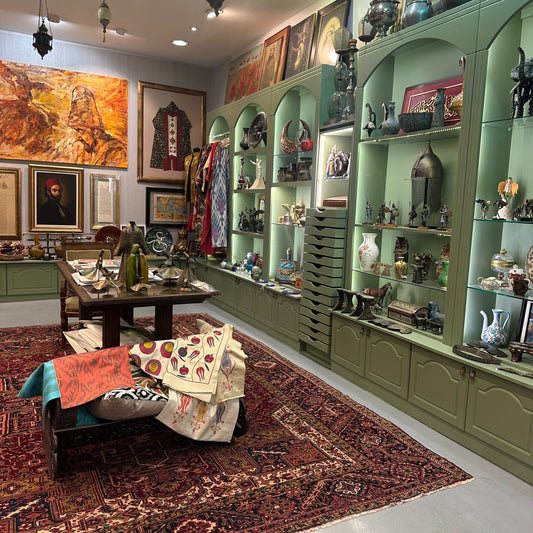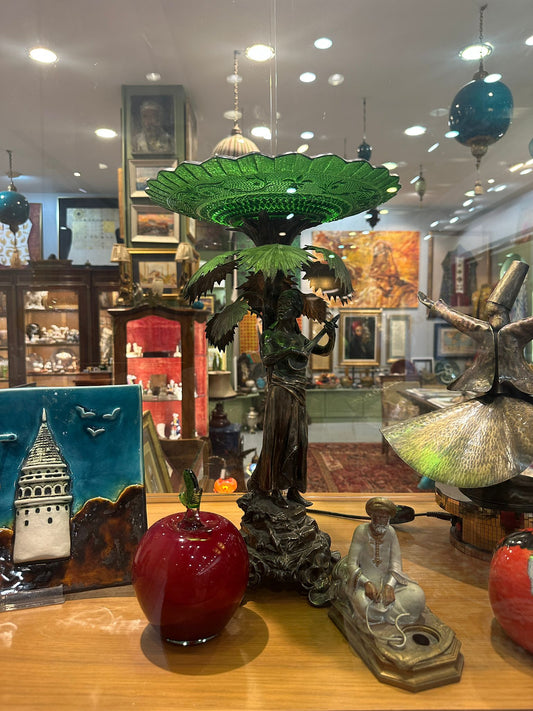Antique ceramics are more than just decorative artifacts; they are the bearers of history and the embodiment of artisanal craftsmanship that has transcended generations. From the ornate İznik tiles of Turkey to the delicate Höchst porcelains of Germany, each piece holds a story, waiting to add depth and elegance to your living space. This blog post explores the rich tapestry of ceramic antiques available, offering insights into how these timeless treasures can be integrated into contemporary homes, enhancing their beauty and historical value.
Understanding the Spectrum of Ceramic Antiques
Ceramic antiques come in many styles, each distinct in origin, technique, and aesthetic. Among the most celebrated are:
- İznik Ceramics: Originating from Turkey, these ceramics are renowned for their vivid floral and geometric designs in rich reds, blues, and greens. İznik pottery, dating back to the 16th century, is perfect for adding a splash of color and historical intrigue to any decor.
- Kütahya Ceramics: Another gem from Turkey, Kütahya ceramics, are known for their detailed artistry and have been a central part of Turkish ceramic art, especially known for the tiles and pottery used in daily life.
- Höchst Porcelains: Crafted in Germany, Höchst porcelains are prized for their elaborate details and exquisite quality. With a history that stretches back to the 18th century, these pieces reflect the high standards of European porcelain artistry.
- Ming Dynasty Porcelain: These highly prized pieces from China are known for their sophisticated underglaze blue and white designs and meticulously crafted shapes. Dating back to the 14th century, Ming porcelain is a staple in any collector's assortment, revered for its quality and historical significance.
- Delftware: Hailing from the Netherlands, Delftware boasts charming blue and white pottery that became especially popular in the 17th century. Its distinctive style makes it a beloved choice for those wishing to add a classical European touch to their interiors.
- Meissen Porcelain: As the first European hard-paste porcelain, Meissen from Germany has a storied past beginning in the early 18th century. Renowned for its quality, detailed figural work, and detailed paintings, Meissen porcelain holds a prestigious place in the world of antique ceramics.
- Sevres Porcelain: This French porcelain is celebrated for its rich colors, especially the iconic Sevres blue, and detailed gilt decorations. Originating in the mid-18th century, Sevres porcelain was often associated with royalty and remains highly valued for its artistry and historical ties.
- Satsuma Ware: From Japan, Satsuma ware is recognized for its cream-colored, crackled glaze and elaborate images often embellished with gold. Originating in the late 16th century, it represents the pinnacle of Japanese aesthetics in pottery, often depicting scenes from daily life or mythology.
These diverse ceramic styles offer a glimpse into the rich tapestry of global cultures and the evolution of ceramic artistry. Each type of ceramic and porcelain holds a unique place in history, offering beauty and decoration and a connection to the past that continues to resonate in contemporary interiors. Collectors and decorators cherish these pieces, integrating them into modern settings where they continue to enchant and add elegance.
Selecting Ceramic Antiques that Complement Your Decor
When choosing ceramic antiques for your home, consider the following to ensure they harmonize with your existing decor:
- Color Coordination: Look for ceramics that either complement or elegantly contrast with the colors in your room. For example, a bright İznik vase can become a focal point in a neutrally toned room, while a subtle Höchst figurine might enhance a space with soft pastels.
- Style Integration: While antique ceramics can stand out as accent pieces, ensuring they don’t clash with the style of your room is crucial. A Kütahya bowl might not blend well in an ultra-modern space unless thoughtfully integrated as a contrasting element.
- Scale and Proportion: The size of the ceramic should fit the scale of where it is being placed. A large ceramic platter might look overwhelming on a small end table, whereas it could make a striking centerpiece on a large dining table.
Tips for Displaying Ceramic Antiques
Displaying antique ceramics effectively enhances their beauty and helps preserve their integrity. Here are some tips:
- Lighting: Proper lighting can dramatically enhance the appearance of ceramic antiques. Use accent lighting to highlight the unique features of each piece without exposing them to direct sunlight, which could fade colors over time.
- Placement: Consider traffic flow and the activity level of different areas in your home. High-traffic areas might pose risks for more fragile items. Displaying them in secure cabinets or on higher shelves can prevent accidental damage.
- Grouping: Create visually pleasing arrangements by grouping smaller pieces together. Group by color, theme, or era, depending on what complements your overall decor style. This tells a story and makes for an intriguing visual display.
Protecting Your Ceramic Antiques
While displaying your ceramics, consider their long-term preservation:
- Environment Control: Ceramics are sensitive to extreme temperatures and humidity levels. Keep them in environments where these factors are stable to avoid cracking or glazing.
- Regular Maintenance: Dust your ceramics regularly and gently with a soft cloth. Avoid using harsh chemicals that could damage the glaze or paint.
- Insurance: For particularly valuable pieces, consider purchasing insurance to protect against potential loss or damage.
The Timeless Appeal of Ceramic Antiques
Incorporating ceramic antiques into your home decor is not just about adorning your space with beautiful objects; it’s about connecting to the past and preserving it for future generations. Each antique ceramic piece you choose transforms your living environment into a historical art gallery.
Whether you’re drawn to the elaborate patterns of İznik tiles, the fine details of Höchst porcelains, or the traditional charm of Kütahya ceramics, Khaftan offers a gateway to exploring these artistic treasures. By selecting, displaying, and caring for these pieces, you enrich your home with a sense of beauty and continuity that only antique ceramics can offer. Let your home tell a story with each piece, creating a decor that is seen, felt, and experienced.
In Khaftan, one can find handmade and unique ceramics and porcelain for every taste and budget. Each piece is meticulously chosen to ensure authenticity and quality, providing our customers with not just decor but a piece of history that enriches their homes and lives.




